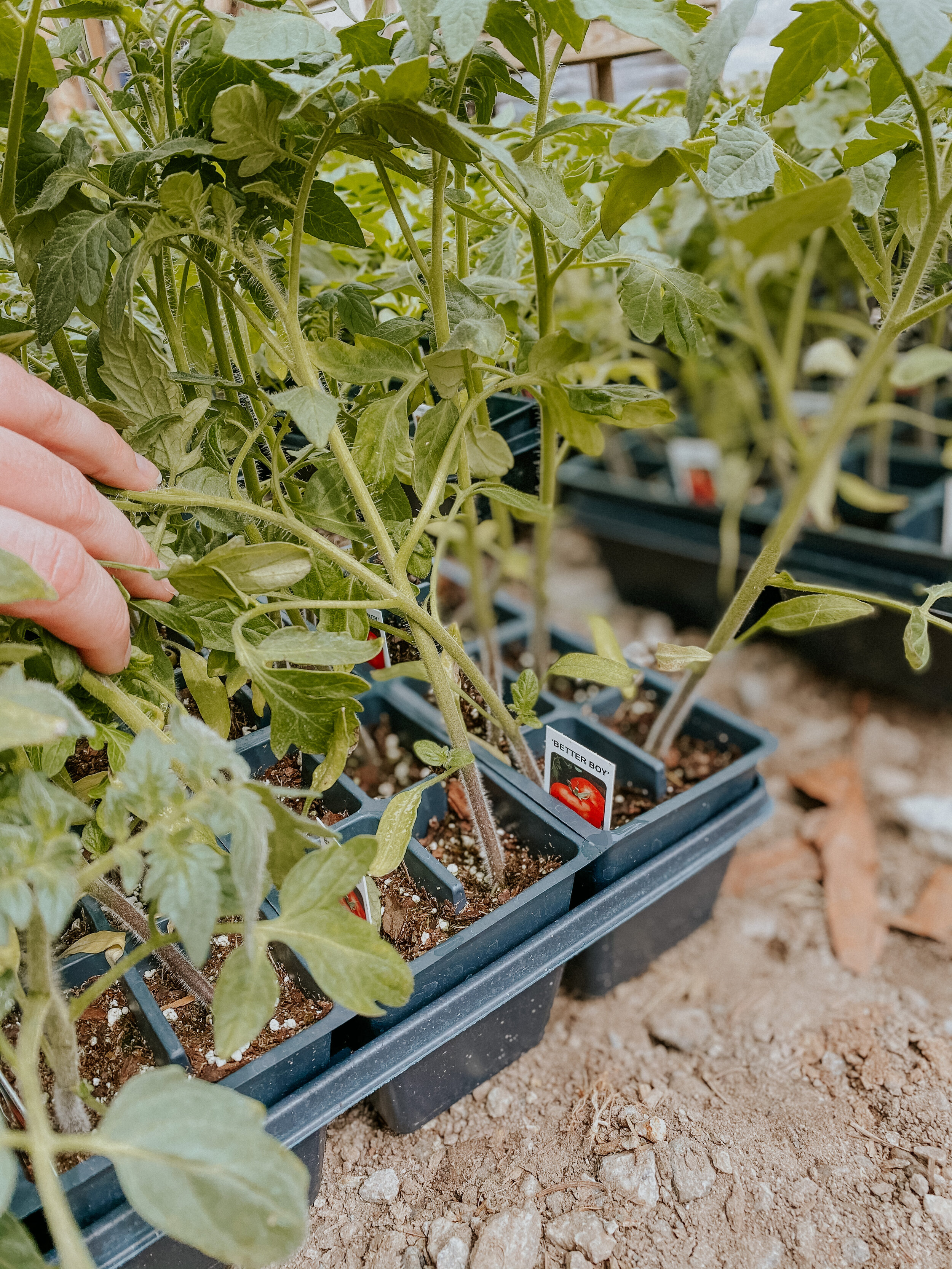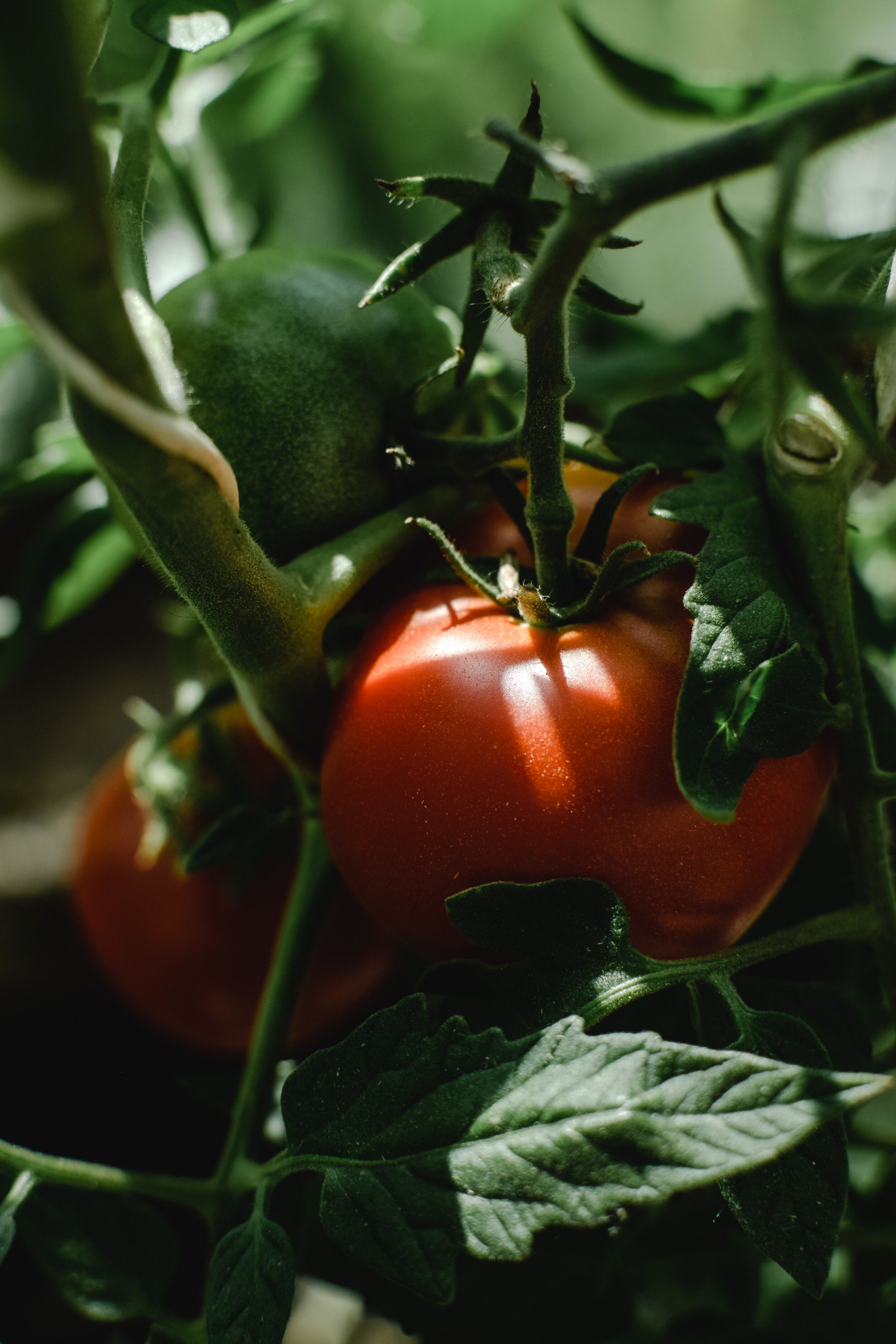
B L O G
6 Pro Tips for Successfully Growing Tasty Tomatoes
Tomatoes are the essence of summer here in North Carolina. Their gorgeous red, orange, purple, and yellow skins, filled with juicy, flavorful centers, leave us craving those fresh tomato sandwiches and homemade sauces all year long. And those gorgeous fruits, while not in short supply here at Garden Valley Farmers Market, can be grown on your own. With a little guidance, we can help you grow the juiciest tomatoes that are full of rich tasting flavor and have your vines overflowing all summer/fall long.
6 Pro Tips for Successfully Growing Tasty Tomatoes
Tomatoes are the essence of summer here in North Carolina. Their gorgeous red, orange, purple, and yellow skins, filled with juicy, flavorful centers, leave us craving those fresh tomato sandwiches and homemade sauces all year long. And those gorgeous fruits, while not in short supply here at Garden Valley Farmers Market, can be grown on your own. With a little guidance, we can help you grow the juiciest tomatoes that are full of rich tasting flavor and have your vines overflowing all summer/fall long.
But before we begin, let’s go over the basics. Tomatoes need three things to grow: LOTS of sun, consistent watering, and proper soil nutrition. Without one of these three things, unfortunately, your tomatoes will not yield the best results and might leave you disappointed this summer. So let’s focus on getting these steps right… and you’ll be golden.
Without further ado, here are Garden Valley’s 6 professional tips for growing delicious, tasty tomatoes:
1. Planting from Seedling (that you purchased at Garden Valley, of course)
WHEN? For zone 7b, which is central North Carolina, it is recommended that you plant your seedlings in late April or early May (a few weeks after your last frost).
HOW? Plant your tomatoes deep into the soil, up to the first leaf. This encourages new root growth from the stems. And the more root growth for your tomato plant means a strong and healthier stem that easily allows nutrients to pass through.
2. Pruning
Pruning is an essential step in growing healthy tomato plants. Tomato plants produce “suckers”, which is just a cute word for branches that grow between the main step and the branch. If allowed to grow, they can produce fruit, BUT they also make it more likely for your plant to develop a disease. Suckers will eventually overcrowd your plant if left to grow, which inhibits the sunlight exposure as well as air flow.
It’s also important to prune any dead branches that may have been damaged via a storm or etc. This will allow the other healthy stems to get all of the nutrients, instead of the dead branch.
Image via Gardening Know How
3. Watering
When first transplanting your tomato plants, lightly water the top layer of soil and be careful not to drown them. We also recommend adding a layer of mulch around the plants to help act as a moisture regulator.
WHEN? When watering, time of day truly does matter. Water your plants as early in the day as possible to prevent an increase of disease chance to your plant.
HOW? To properly water, slowly water around the stem of the plant, allowing sufficient time for the soil to soak it up. Do not drench your leaves, because unfortunately, wet leaves encourage disease. Watering around your stem, not directly on it, will also encourage outward root growth.
Your tomato plants will probably need a daily water check as well. If they look a little droopy/wilted, it’s probably time to water them.
4. Light
Full sun. Period.
5. Feeding
Tomatoes need lots of help with nutrients, and your backyard soil probably doesn’t cut it. Tomatoes LOVE nitrogen, which helps them grow healthy, tall, and FULL of fruit. So adding a good compost mix to your soil before planting will help your plants out tremendously. We also recommend fertilizing with a tomato specific fertilizer throughout the growing period to give them an added boost of nutrients.
FARMER’S TIP
Add a raw fish and crushed egg shells at the base of your tomato when planting. Your tomatoes will thank you.
6. Support
Tomatoes need lots of support due to the heavy fruits that they produce. These fruits will cause the branches to fall and lay on the ground, which will cause rot to your tomato. They are also susceptible to wind damage, so using tomato cages are the perfect way to protect your plants from themselves and natural surrounding elements.
Image via HGTV
5 Potential Pesky Pests and Problems
Tomato Horn Worm- those green giant worms that love to eat your ENTIRE plant. You can just pluck these off and chuck them far, far, far away.
Aphids- Can be controlled with ladybugs (which love to feast on aphids) or a homemade organic insecticidal soap (1 T castile soap : 1 qt. water)
Slugs- sprinkle diatomaceous earth around your plant to prevent them from entering
Blossom End Rot- black spots on fruit, which basically means your plant needs more calcium. Just add a good tomato fertilizer and that should help.]
Cracked Fruit- caused by inconsistent watering. Will usually heal over time.
From Garden Valley:
We wish you nothing but the best growing season, and that your tomato plants produce fruit “coming out of your ears”. If you need ideas on how to use your tomatoes, you can, of course, try this delicious Tomato Tart. OR you could try out this mouth watering Sicilian Pasta Sauce made by our own Susan Laparra. OR you could just make a good ole’ fashioned Southern Tomato Sandwich.
Whichever way you choose to use your tomatoes, we want to see them. Don’t forget to tag us on Facebook, Instagram, and TikTok! We can’t wait to see! @gardenvalleyfarmersmarket
How and When To Prune Your Shrubs
Pruning is an essential part of a plant’s life. Not only does it make your shrub look refreshed, but it also encourages healthy growth and sustainability for your plant to last year after year. And if you follow these steps on how and when to prune your shrubs, you’ll having your gorgeous shrubs lasting quite a long time.
Pruning is an essential part of a plant’s life. Not only does it make your shrub look refreshed, but it also encourages healthy growth and sustainability for your plant to last year after year. And if you follow these steps on how and when to prune your shrubs, you’ll having your gorgeous shrubs lasting quite a long time.
Why You Should Prune Your Shrubs
So why do it? Well, as plants grow, mature, and produce seeds/fruit/flowers, a little bit of maintenance and love is required from us. Pruning is the act of removing branches, leaves, and buds from a plant in order to make it more attractive, or to maintain its health.
Why take the extra time? Because your plant relies HEAVILY on it. Pruning removes any dead, dying, or diseased portion of the plant and helps to prevent spreading any disease throughout. Pruning also allows more light and air to pass throughout the plant, giving it more nutrients and allowing room for new growth.
Another common reason to prune would be what’s called “training” or “shaping”, which is when you want to shape a tree, hedge, or shrub. Training is accomplished by cutting branches to restrict growth. It also reduces the amount of branches, so an increase in energy and nutrients can go to all the other stems to produce more flowers/fruit.
When to Prune
It's important to remember to research your plant's specific needs, because no plant is the same as the other. However, here is a basic guideline that can assist you when there are no resources at hand:
Flowering Shrubs- prune immediately after blooming has ended
Non-Blooming Shrubs- prune late Winter or early Spring
Seasonal Pruning Guideline
Late winter is usually a time to prune fruit trees, non-flowering shrubs, trees, hedges, and berried shrubs/trees.
Spring is a time to prune any summer flower shrubs that have not bloomed yet.
Late spring pruning involves cutting back spring flowering shrubs that have already bloomed.
Summer is a great time to prune summer flowers after they have finished blooming.
Fall is a great time to prune roses, and also to remove any annuals that are finished with their season.
How to Prune
The two ways to prune your plant are by Heading + Thinning.
1. Heading
Heading is cutting off part of a branch in order to make the rest of the remaining branch stronger. It is used when new growth is wanted. If you are wanting new growth, you will want to cut the branch/stem just above the bud at an angle, remembering not to cut too close to the bud, but also not too far away. It may sound complicated, but we would be glad to show you how this achieved if you stop by one of our locations here in North Carolina.
2. Thinning
Thinning is cutting off a branch at its origin to prevent any new growth. This could include cutting to the main trunk or even to the ground. Often times a “thinning” technique is used when you are wanting to increase air flow and light to the plant. This helps to prevent diseases and boosts the bud and fruit production.
Pruning is an art that can seem complicated and difficult at first. But, once the basics are learned, it can become a freeing and therapeutic experience. And maybe we, as humans, can take a few principles from pruning, and apply them to our lives to make us stronger and healthier versions of ourselves. Because sometimes removing something, can actually be freeing at the end of it all.
Happy Pruning,
Your GVM Team





















